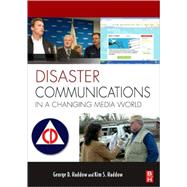
What is included with this book?
| Communications: The Critical Function Essential to success | |
| Best case examples where effective communications clearly contributed to the success of the operation | |
| Northridge for response, Napa for mitigation | |
| Worst case examples where inadequate and inept communications planning and implementation costs lives, damaged response, or delayed recovery | |
| Hurricane Katrina, the Loma Prieta earthquake | |
| Disaster communications in a changing media world | |
| Definition of new media, examples of use in disasters | |
| Katrina, July 7 London bombing, Examples of changing role of traditional media and government --9/11 | |
| The Principles of a successful communications strategy Basic assumptions and examples of each | |
| Transparency | |
| Accuracy | |
| Accessibility | |
| Customer focus | |
| Leadership commitment | |
| Communications core to planning | |
| Partnership role with media | |
| Need to create emotional connection with audience, be trusted | |
| Rudy Giuliani on September 11, Chief Moose in the DC sniper incident | |
| Application of principles to all four phases of disaster | |
| Mitigation | |
| Preparedness | |
| Response | |
| Recovery | |
| The challenges of communicating risk | |
| Identification of audiences | |
| Public | |
| Elected officials and community leaders | |
| Partners - public health, first responders, volunteers | |
| Media | |
| Creating infrastructure | |
| Staffing | |
| Tools and technologies | |
| Working with the media | |
| How a newsroom works, staffing, deadlines | |
| How the internet works | |
| Experts, visuals, first hand accounts, constancy of information | |
| New trends in informational dispersal Challenges of having the truth heard in a cluttered, chaotic world where everyone is a reporter | |
| Turning that trend to your advantage | |
| Resources | |
| Table of Contents provided by Publisher. All Rights Reserved. |
The New copy of this book will include any supplemental materials advertised. Please check the title of the book to determine if it should include any access cards, study guides, lab manuals, CDs, etc.
The Used, Rental and eBook copies of this book are not guaranteed to include any supplemental materials. Typically, only the book itself is included. This is true even if the title states it includes any access cards, study guides, lab manuals, CDs, etc.